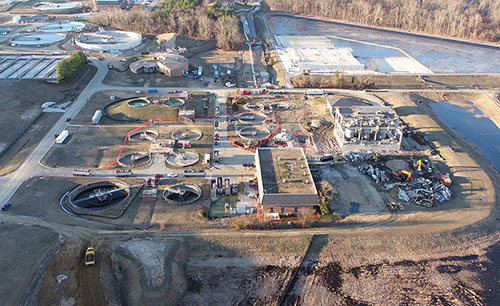It’s a clearly surreal experience looking at last year’s record-setting Top 200 Environmental Firms revenue results through the current lens of five months of punishing economic impact to companies and their clients from the still-unfolding COVID-19 pandemic and the much jostled energy sector.
For Top 200 observers and participants, it seems hard to believe that a group that generated $58.9 billion in 2019 global environmental services revenue now has seen and continues to face work delayed or canceled, clients in major financial turmoil and forced shifts in staff numbers and work rules that leave this year’s results in question and some firms having to tap federal assistance to cover payroll and stay in business. But even with the bumps, firms are banking on last year’s foundation and adjustments to the “new abnormal” to gain strength in 2020 and beyond, with many finding ways to manage through the pause and taking advantage of pandemic-driven opportunities.
Click here for the names and ranks of the 2020 Top 200 Environmental Firms.
With public and private sector work at full tilt in 2019, the Top 200 revenue total rose 2.8% from the previous year’s also strong increase. Domestic revenue was up 3.4% to $45.2 billion and non-U.S. markets stayed steady to generate $13.7 billion in revenue.
“2019 was a good year for TRC’s environmental business due to overall economic conditions and infrastructure spending in key markets,” says Mark Robbins, unit president. “As for all firms in our space, the pandemic has had a material impact. The outlook for the next 12 months is steady incremental improvement with a return to growth in the back half of the period.”
Sovereign Consulting Inc. was “on pace” to increase 2020 revenue by up to 7% early in the year, says President Ravi Gupta, who now expects as much as a 10% drop “due primarily to client shutdowns, the plummeting price of oil and the inability to provide services due to state restrictions.” With more focus on its bottom line, the firm is “still on track for a profitable year” and expects restored demand for its private-sector hazardous waste management services in late 2020 “if the pandemic lifts,” he says.
Mott McDonald North America CEO Nicholas DeNichilo “expects no change in the environmental market,” he says, pointing to “optimism based on potential government stimulus programs in water and wastewater, renewables and general environmental assessments related to large-scale infrastructure projects.”
List participation also had an impact on Top 200 results. Not reporting revenue for 2019 was publicly traded Fluor Corp., ranked fifth last year with $2.06 billion in list revenue. Scrutiny of project charges taken last year prompted a federally required internal audit that prevents current publication of its corporate financial data. Also not responding was waste management giant Clean Harbors Inc., ranked third in 2019.
Even so, 15 Top 200 firms reported billion-dollar environmental services revenue totals, up from 11 the previous year, including Italy-based water and clean energy contractor Salini-Impregilo S.p.A., renamed this year as WeBuild.
Coming in just above that threshold is list newcomer U.S. Ecology, the new parent of previous Top 200 firm NRC Group that was acquired last November in an estimated $966-million transaction between the two specialists in hazardous and nuclear waste management and emergency response. “We believe the combination creates a true leader in industrial waste management and environmental services,” said U.S. Ecology CEO Jeffrey Feeler at the deal closing.
“We expect no change in the [post COVID-19] environmental market … with optimism based on potential government stimulus programs in water and wastewater, renewables and environmental assessments related to the large-scale infrastructure market.”
– Nicholas DeNichilo, CEO, Mott McDonald North America
Also adding to list momentum is new participant Mortenson, which ranks No. 5 with nearly $1.5 billion in renewable energy construction revenue, Its debut, as well as other firms’ growth in air quality and clean energy, boosted the sector by 83% in Top 200 market share and by a whopping 141% in total revenue, to more than $5 billion.
“Power sector renewables are a bright spot and growth market,” says Frank Sweet, AECOM Americas environmental business executive vice president. “Major oil and gas industry firms such as BP are making a top-level commitment to renewables, and all may be heading in that direction.” The firm handles environmental permitting for solar and offshore wind projects.
List perennials Jacobs, WSP and Tetra Tech also posted solid revenue gains.
No. 2-ranked Jacobs says its environmental solutions group had double-digit revenue growth in 2019 as did its water business. For WSP, growing environmental services “is at the heart” of its global growth strategy. The firm cites environmental firm acquisitions and 8% global organic growth and predicts benefits “will fully materialize” in 2020 to boost worldwide revenue by about 20%. Whether—or how soon—that strategy includes execution of the much speculated acquisition of Top 200 leader AECOM remains to be seen.
Also being watched are 2019 Trump administration rollbacks in federal environmental regulations, augmented this year by such actions as revamped agency clean air rules and presidential emergency orders that waive compliance on the U.S.-Mexico border wall and on expedited infrastructure projects announced in May as a pandemic stimulus.
Most recently as an apparent pre-election pandemic stimulus, on July 15, the administration announced rollbacks in finalized regulations under the National Environmental Policy Act (NEPA), which has been core to assessing project environmental impact on communities and on climate change.
The revised version would exempt some project categories from NEPA review and ease other requirements. While construction and business sector groups see benefits to needed project progress, the changes are steadfastly opposed by environmental groups and face lawsuits, as well as overturning by a potential Democratic president.

Photo: PC Construction
“Our clients will still want well-documented plans that won’t be challenged,” says AECOM’s Sweet. “Digital environmental impact statements will make analysis much easier to use and navigate and will have a more positive result than EPA’s reduction in requirements.”
Steve Nalefski, environmental vice president and general manager at Burns & McDonnell, notes that new market uncertainty is impacting the firm’s electrical transmission customers because of recent legal challenges to the NWP-12 permit that governs water-crossing oversight by the U.S. Army Corps of Engineers. The Corps now must revise the nationwide permit, which also is critical to fast-tracking oil and gas projects.
Hazardous waste cleanup and management remains the dominant Top 200 niche, but it fell 7.6% last year in market share and by 4.7% in total dollars. Pickup across that sector and others is likely with new state and federal regulation of emerging chemical contaminants PFAS. Several states, most recently New Hampshire and New Jersey, have issued new rules for PFAS’s in drinking water while the EPA weighs their official designation as hazardous substances, says Glen Kirkpatrick, VHB site investigation and remediation national director. “Scientific community understanding of PFAS toxicity and fate and transport in the environment continues to evolve, making it particularly important for practitioners to stay at the leading edge of knowledge,” he says.
“We haven’t seen anyone say we will go back to the low energy costs of hydrocarbons. Clients want help to transition.”
– Joe Sczurko, CEO, Wood Technical Consulting Solutions Unit
Nuclear waste remediation and management also decreased in both categories by double digit amounts. But big contracts at the federal Hanford cleanup site in Washington were just awarded, and the House Armed Services Committee’s $700-million boost in early July to U.S. Energy Dept. nuclear waste cleanup funding for fiscal 2021 could aid this year’s revenue total.
“We view the 2020 market as favorable based on the large volume of procurements currently being supported in addition to large volumes of upcoming bids in Q3 and Q4, assuming COVID-19 issues subside,” says Mark Duff, CEO of Perma-Fix Environmental Services, which reported 80% of revenue in that niche.
Design and construction of industrial and municipal wastewater treatment facilities remained strong last year, boosting total revenue 11.5% and market share 8%. The wastewater sector accounts for 20% of the Top 200 total. Water supply and treatment work was less robust, falling 4.8% in total revenue and losing 7.6% in market share.
Design firm Garver, which rose nearly 30 spots based on 2019 revenue growth, projects a further 40% spurt this year, fueled by growth in Texas and roles in large drinking water programs in Enid, Okla., and Wichita, Kan.—the latter a $1-billion effort to meet federal mandates that includes major sewage treatment plant upgrades. Contractor Wharton-Smith Inc. also notes “many larger size CM at-risk and design-build water and wastewater projects in our backlog.” In non-U.S. markets, the sector also is strong.
Jacobs won an extension last year of its professional services contract with Watercare, a large Auckland, New Zealand, water-wastewater utility to include construction management and design support on the country’s largest-ever wastewater project through 2025. But Craig W. Brunner, president of engineer Donohue & Associates, says, “We’ll wait to see whether lower municipal water and wastewater revenue from COVID-19 impact capital projects.”
Top 200 firms have stepped forward in the short term to aid virus-impacted clients with everything from PPE supply to jobsite and office safety protocols and outsourced operations as immediate revenue generators.
For EBI Consulting, which does real estate transaction due diligence, there are signs of success so far. “Last week we had new project books that were the best in three months, so maybe it’s a restart,” says Don Spinogatti, marketing senior vice president. “We’ll see if it’s a trend.”
But executives also see the convergence of pandemic and energy market disruptions as a new catalyst for the environmental services sector to generate more profound industry change. “Environmental markets are at a critical nexus,” says Kurt Beil, GHD northern hemisphere environment market leader. “COVID-19 is a major catalyst for technology and has created a breeding ground for innovation in markets.”
Joe Sczurko, CEO of Wood’s technical consulting solutions unit, notes the key role for Top 200 firms in easing client adjustment to a “completely different world” of post-COVID-19 and clean energy transformation. “We haven’t seen anyone say we will go back to the low energy costs of hydrocarbons,” he says. “Clients want help to transition.”
Liz Trew, a leading U.K.-based environmental consulting sector analyst, says the pandemic is “the wake-up call to reset systems laced with green conditions.” She points to new “black swan risks and the green swans they may spawn.”
Data support by Gary J. Tulacz and Katie Cooper







Post a comment to this article
Report Abusive Comment